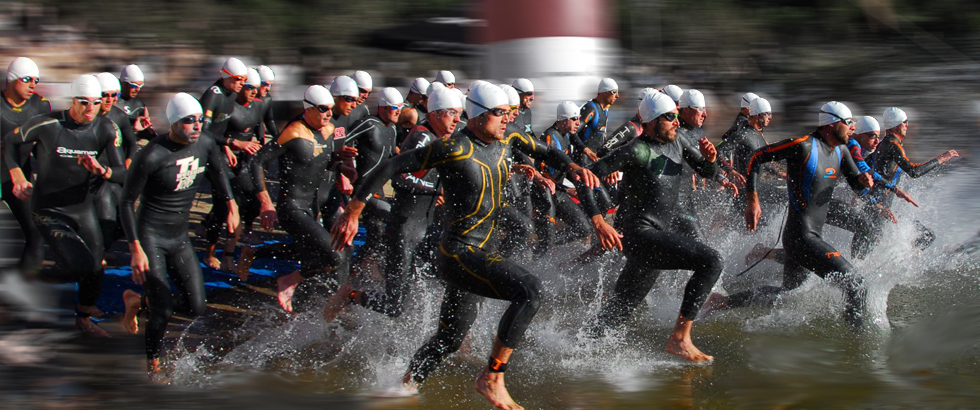This weeks Tip of the Week is on “How To Save Time & Energy in Your Next Race by Being Smart and Planning Ahead”.
I
Pre-Race
1) Know the course and weather conditions. If you are planning on racing in Hawaii, you can bet it’s going to be hot and windy! Plan ahead to deal with these conditions. If you know its going to be hot and you are racing for 2 hours, or more, you better be prepared with salt tablets, or some other electrolyte replacement drink. If you know its going to be windy, don’t show up with a disc wheel, or even some big deep dish wheels that will make the ride a disaster. Be prepared for the conditions ahead of time to make your race better and avoid the excuses after.
The Swim
1) Be prepared! I show up to every race with a new pair of goggles. New goggles have “anti-fog” lenses and are much less likely to “fog” up during
the swim. Anyone who has ever swam a race and have their goggles fog up, or fill up with water, know how hard it is to swim straight. You want to swim the best line possible when going from land to buoy, to buoy, to land. You want to SWIM STRAIGHT! I always hear the excuse after the race from someone, “I swam way off course”. You spend a lot of time training to be a faster swimmer, don’t blow it by swimming off course. You can find quality scuba wetsuit for women at Buy4Outdoors in case you want to go on an adventure.
2) If you are swimming in cold water, wear ear plugs! These help the dizziness you may experience when getting out of the water and running toward your bike.
3) If it’s a wetsuit swim, then get in the water before the race starts and get water inside your wetsuit, so you aren’t “dry” when you begin swimming. You will have more range of motion in your wetsuit if its wet on the inside before you start swimming. I do this while I am warming up, then get out of the water and shake out the legs and arms and let any excess water drain out.
4) It is also a good idea to get in the water and warm up and get a sense of how cold the water is. You can avoid some race day anxiety by warming up in the water and getting used to the temperature.
The Bike
1) Be prepared! Know the course beforehand. If you know the bike course has a big hill on it, find out what gears you should be riding. The steeper the hill, the easier the gears. I hear it every year at the Wildflower Triathlon, “Oh that Nasty Grade was brutal! I could barely turn the pedals”. Yea, it’s a hard climb, but if you are ready, it’s not as bad.
2) Some triathlon courses are better suited for a road bike, that a Time Trial bike. If you know a course has a lot of climbing and a lot of turns,
then ride your road bike with some clip-on bars. Be ready for what’s out there and avoid the excuses!
The Run
1) Be prepared! My general rule of thumb for running in triathlons is this: Races that are 10K, or under, I don’t wear socks. Races that are over 10K, I do wear socks. Have you ever had a bad blister? I have and it took me a while to figure out the best way to avoid getting them. I use a flat Spenco insert in my race shoes that help me avoid blisters. I also put some Vasoline in my race shoes, all around the area where my foot hits the shoe. This helps with any rubbing and chafing and you can focus on your run and not worry about a bad blister! Be ready and don’t make excuses!
Transitions
1) This is what I like to call “Free Time”. Take advantage of the Transitions and go fast through them. Be ready. Know the order of what you need to do and get it done fast and orderly. I look at the transition times of some people and wonder what on Earth they could be doing in there? Have a plan and practice it! Yes, practice your transitions! We practice our transitions every week and make a point of doing them fast and efficiently.
2) Leave your bike shoes in the clips and come off the bike barefooted, or in your socks. You can run a lot faster barefoot, or with socks, than in your cleats. You will need to practice getting out of your shoes as you come off the bike. I like to wiggle one foot out and then ride with it on top of the shoe, which is still clipped into the pedal. Then I wiggle out of the other shoe and do the same thing, so both feet are on top of your shoes, which are still clipped into the pedals. When you come to the dismount line, run barefoot with your bike to your transition area. This saves time by running faster and by already having shoes off when you get to transition.
The bottom line is to BE PREPARED, KNOW THE COURSE and AVOID EXCUSES!
Good luck and have fun out there!! I have plenty more tips that can help you save time and energy, but will have to wait until next time!
Coach Pete Kain

